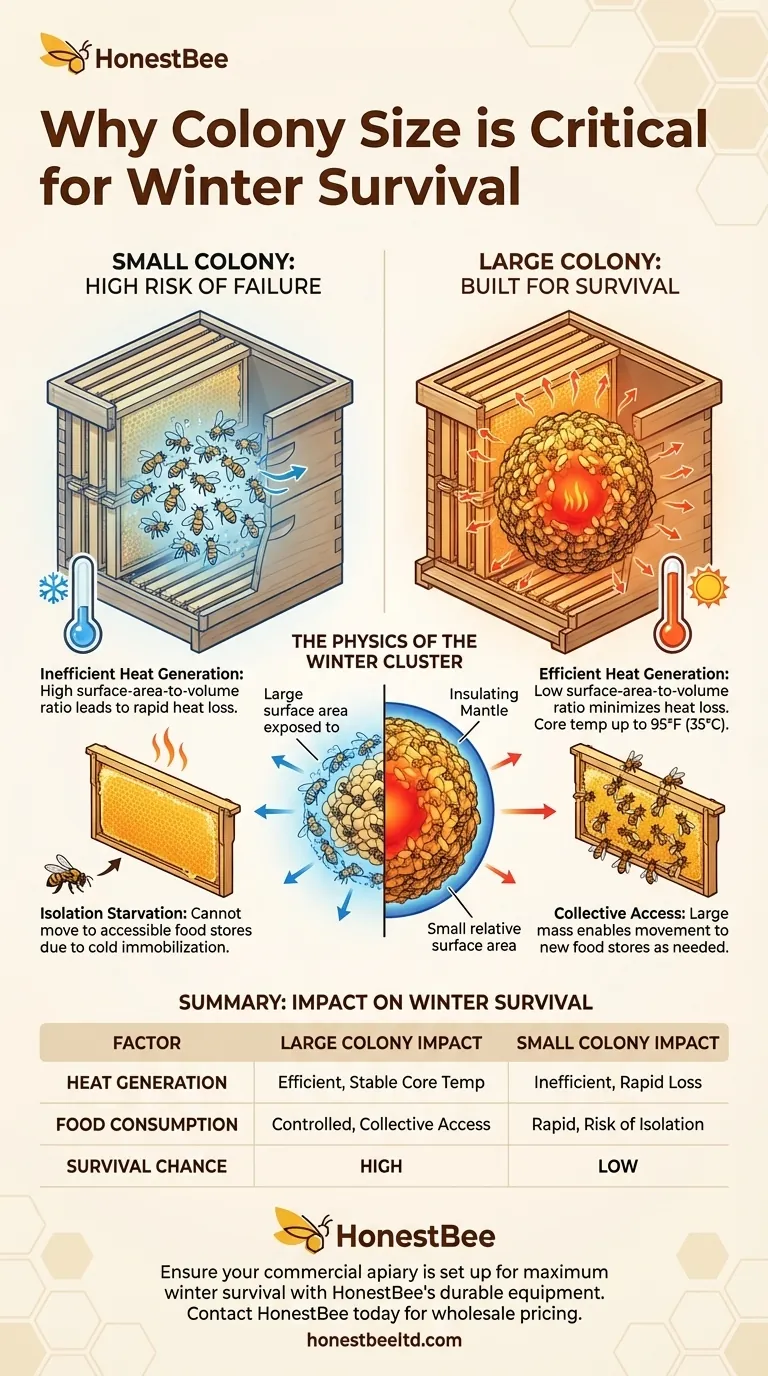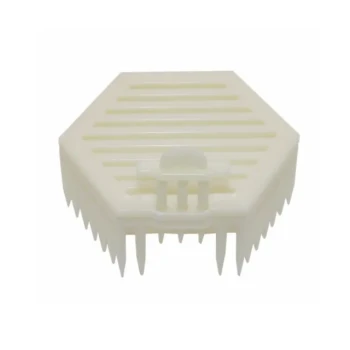To put it directly, colony size is the single most important factor in determining whether a honey bee colony will survive the winter. A hive with too few bees cannot generate sufficient heat to keep the central cluster warm, nor can it effectively move to new food stores as winter progresses. This combination of heat loss and potential starvation is almost always fatal for a small population.
The core principle to understand is that bees do not heat the hive; they heat themselves. A large, dense population functions as a single, heat-generating organism with an efficient surface-area-to-volume ratio, allowing it to survive extreme cold by minimizing heat loss and collectively accessing food.

The Physics of the Winter Cluster
To grasp why population size is so critical, you must first understand the mechanics of the honey bee winter cluster. This is not a random collection of bees; it is a highly organized structure engineered for survival.
A Living, Breathing Furnace
Individual honey bees cannot survive when their body temperature drops below 50°F (10°C). To combat this, they form a tight cluster and generate heat by contracting their powerful flight muscles without moving their wings, a process known as thermogenesis. The center of this cluster is kept at a stable, warm temperature, often around 90-95°F (32-35°C) if brood is present.
The Insulating Mantle
The cluster has two distinct zones. The bees in the core generate heat and care for any brood, while the bees on the outer layer form a dense, insulating mantle. These outer bees press their bodies tightly together, orienting themselves to minimize heat escape, effectively creating a living shield against the cold air.
The Critical Role of Mass
The efficiency of this system is dictated by physics, specifically the surface-area-to-volume ratio. A large, spherical cluster has less surface area exposed to the cold relative to its total volume (its heat-generating core). A small cluster, by contrast, has a much higher proportion of its bees on the exterior, constantly losing heat and working harder to stay alive.
Why a Small Colony Fails
A small population faces two insurmountable challenges that directly result from its lack of mass.
Inefficient Heat Generation
In a small cluster, a significant percentage of the bees must be on the insulating mantle. This leaves fewer bees in the core to generate heat. The outer bees chill faster and must constantly rotate inward, a process that expends enormous amounts of energy and rapidly consumes honey stores.
The Risk of Isolation Starvation
The most tragic winter failure is a hive full of honey with a dead cluster of bees. This happens when a small cluster consumes all the honey within its immediate reach. Because the cluster is small and struggling to stay warm, it cannot break formation to move just a few inches to an adjacent frame of honey. It becomes immobilized by the cold and starves.
Common Pitfalls and Misconceptions
Understanding the reality of the winter cluster helps avoid critical mistakes in hive management.
Misconception: The Hive Must Be Heated
A common mistake is to think of the hive box as a house that bees need to keep warm. Bees do not heat the hive interior. They only heat the cluster itself. While reducing drafts is important, excessive insulation without proper ventilation can trap moisture, which is often more deadly than the cold itself.
The False Economy of Weak Hives
Many beekeepers are reluctant to combine a weak hive with a strong one, feeling like they are "giving up" on a colony. In reality, attempting to nurse a critically undersized colony through winter is a low-probability gamble. It is far more effective to combine it with a stronger hive in the fall, ensuring the survival of the bees and the queen.
Making the Right Choice for Your Colony
Your late-summer and early-fall inspections are your final opportunity to set your bees up for success. Your actions should be guided by a realistic assessment of colony population.
- If you find a weak colony (fewer than 4-5 deep frames of bees): Your best action is to combine it with a stronger, queen-right colony using the newspaper method.
- If you have several moderately-sized colonies: Ensure their honey stores are consolidated and positioned directly above and around their current position, making it easy for the cluster to access.
- If you have a strong, populous colony: Your focus should be on verifying they have more than enough food stores (e.g., 60-90 lbs depending on your climate) and ensuring top ventilation to prevent condensation.
Ultimately, a robust population is the engine of winter survival, and preparing for winter is about maximizing bee numbers before the cold arrives.
Summary Table:
| Key Factor | Impact on Winter Survival |
|---|---|
| Large Colony Size | Creates an efficient winter cluster with a low surface-area-to-volume ratio, minimizing heat loss and preventing isolation starvation. |
| Small Colony Size | Leads to inefficient heat generation, rapid honey consumption, and a high risk of starvation even with ample food stores nearby. |
| Late-Summer Population | A strong population of bees covering 8-10 frames is the primary indicator of a colony's ability to survive winter. |
Ensure your commercial apiary is set up for maximum winter survival. HONESTBEE supplies the durable beekeeping equipment and supplies that commercial beekeepers and distributors rely on for healthy, populous colonies. From insulated hive bodies to essential feeding systems, our wholesale-focused operations provide the tools you need for success.
Contact HONESTBEE today to discuss your winter preparation needs and wholesale pricing.
Visual Guide

Related Products
- Wholesales Dadant Size Wooden Bee Hives for Beekeeping
- Automatic Honey Flow Beehive 4 Frame Mini Hive for Beekeeping
- Professional Galvanized Hive Strap with Secure Locking Buckle for Beekeeping
- Professional Wide Blade Honey Scraper for Beekeeping and Honey Processing
- Professional Long-Handled Silicone Honey Scraper for Beekeeping
People Also Ask
- What is beekeeping equipment? Essential Tools for Commercial Apiaries & Distributors
- What are the advantages of wooden bee hives? Superior Bee Health & Beekeeper Flexibility
- What are the essential pieces of equipment for most beekeepers? Get Started with the Right Gear
- What should beginners consider when purchasing beekeeping equipment? A Guide to Essential Starter Gear
- What should you do if you find an ant nest near your beehive? Essential Strategies for Hive Protection



















